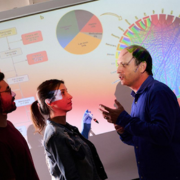TAU devises computer program to combat PTSD
Tel Aviv University, NIMH, and Creighton University researchers devise a computerized training program to curb debilitating syndrome for veterans
Some 10-15 percent of combat veterans struggle with wounds invisible to the naked eye: post-traumatic stress. Their lives are ridden with debilitating symptoms: insomnia, flashbacks, depression, anxiety, guilt, and ever-present tension. While there is no cure-all for post-traumatic stress disorder (PTSD), cognitive behavioral therapy — which actively reprocesses traumatic events to reduce symptoms — has seen some success.
A new study from researchers at Tel Aviv University, Creighton University in Omaha, Nebraska, and the National Institute of Mental Health suggests an entirely new approach to treating PTSD. The research discusses a cutting-edge computer program capable of alleviating PTSD symptoms by reducing fluctuations in attention toward and away from perceived threats. The research was published in the American Journal of Psychiatry and led jointly by Dr. Yair Bar Haim, head of TAU's School of Psychological Sciences and director of TAU's Laboratory for Research on Anxiety and Trauma, Dr. Daniel Pine of the NIMH Emotion and Development Branch, and Dr. Amy Badura-Black of the Department of Psychology at Creighton University.
"This approach is entirely different from existing treatments," said Dr. Bar Haim. "Our approach is bottom–up. Our targets are basic, attention-level cognitive processes. We try to normalize and regulate this behavioral system by providing very simple computer tasks, retraining the neural network to better balance threat vigilance and avoidance.
"Our results were promising," Dr. Bar Haim reported. "The program produced a significant reduction in severe PTSD symptoms, with a similar success rate as cognitive behavioral therapy."
The human threat-monitoring system
According to Dr. Bar Haim, humans have a "threat monitoring system" which fluctuates all the time, generating responses to potential threats in the environment and nullifying reactions to non-threatening stimuli.
In the computer training program, two stimuli (threatening or neutral) appear on the screen, followed by a target (an arrow) pointing left or right. The researchers hope to retrain the participant's neural network to regain the balance between threat avoidance and threat vigilance. The treatment entailed four to eight sessions of computerized training, each of which lasted 10-15 minutes.
"In PTSD, the system is in disarray, with high fluctuations — between vigilance to threats on one hand and threat avoidance on the other," said Dr. Bar Haim. "Our promising new treatment for PTSD targets a neurocognitive mechanism to mediate that system, and change attention patterns that go in disarray. If you can influence this pattern, maybe you can affect other symptoms of PTSD."
The training implicitly teaches participants that threatening stimuli are irrelevant to performing a specific task, requiring them to attend equally to threatening and neutral stimuli. The study determined that the training program reduced symptoms by reducing this variability in attention.
A safety (Inter)net for vets?
For the purpose of the study, teams of researchers from TAU and Creighton University conducted parallel trials testing the program on US and Israeli combat veterans; the results in both groups were the same.
"Our cost-effective treatment could even one day be available over the Internet," said Dr. Bar Haim. "You would need a psychologist to diagnose you and monitor your treatment, but the therapy itself could be administered over the Internet or through short visits to the clinic."
The researchers are continuing to explore the effect of the program on larger samples in Israel and in the US.
This article was originally published by AFTAU.






